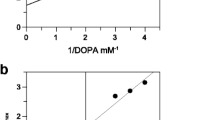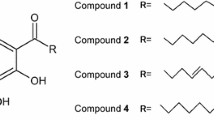Abstract
In the course of searching for new materials to use as whitening agents, we screened 19 methanol extracts prepared from 14 medicinal plants from Central Kalimantan province, Indonesia. The screening methods used were the 1,1-diphenyl-2-picrylhydrazyl (DPPH) radical-scavenging assay, a tyrosinase inhibition assay, and a melanin formation inhibition assay using B16 melanoma cells. The extracts of Willughbeia coriacea (bark part of aerial root), Phyllanthus urinaria (root), Eleutherine palmifolia (bulb), Eusideroxylon zwageri (seed), Dendrophthoe petandra (aerial root), Passiflora foetida (stem), and Vitex pinnata (root) showed DPPH radical-scavenging activity of more than 70% at 100 µg/ml. The extracts of W. coriacea (bark part of aerial root), P. urinaria (root), and D. petandra (aerial root) showed tyrosinase inhibitory activity of more than 40% using l-tyrosine as a substrate at 500 µg/ml. The extracts of W. coriacea (bark part of aerial root) and D. petandra (aerial root) showed tyrosinase inhibitory activity of more than 40% using l-DOPA as a substrate at 500 µg/ml. The extracts of W. coriacea (bark part of aerial root, 200 µg/ml), Glochidion philippcum (aerial root, 200 and 300 µg/ml), E. palmifolia (bulb, 50 µg/ml), E. zwageri (seed, 100 µg/ml), D. petandra (aerial root, 200 µg/ml), Lansium domesticum (bark, 25 µg/ml), P. foetida (stem, fruit, 300 µg/ml), and Solanum torvum (root, 300 µg/ml) strongly inhibited the melanin production of B16 melanoma cells without significant cytotoxicity. These findings indicate that some medicinal plants from Central Kalimantan are potential ingredients for skin-whitening cosmetics if their safety can be confirmed.
Similar content being viewed by others
Change history
25 February 2022
A Correction to this paper has been published: https://doi.org/10.1007/s11418-022-01611-8
References
de Padua LS, Bunyapraphatsara N, Lemmens RHMJ (1999) Plant resources of South-East Asia: medicinal and poisonous plants. Prosea 12(1):27
Subeki S, Nomura S, Matsuura H, Yamasaki M, Yamato O, Maede Y, Katakura K, Suzuki M, Trimuningsih T, Chairul C, Yoshihara T (2005) Anti-babesial activity of some Central Kalimantan plant extracts and active oligostilbenoids from Shorea balangeran. Planta Med 71:420–423
Krismawati A, Sabran M (2004) Pengelolaan Sumber Daya Genetik Tanaman Obat Spesifik Kalimantan Tengah. Buletin Plasma Nutfah 12:16–23
Sánchez-Ferrer A, Rodrígez-López JN, García-Carmona F (1995) Tyrosinase: a comprehensive review of its mechanism. Biochim Biophys Acta 1247:1–11
Wang KH, Lin RD, Hsu FL, Huang YH, Chang HC, Huang CY, Lee MH (2006) Cosmetic applications of selected traditional Chinese herbal medicines. J Ethnopharmacol 106:353–359
Sturm RA, Teasdale RD, Box NF (2001) Human pigmentation genes: identification, structure and consequences of polymorphic variation. Gene 277:49–62
Perluigi M, De Marco F, Foppoli C, Coccia R, Blarzino C, Marcante ML, Cini C (2003) Tyrosinase protects human melanocytes from ROS-generating compounds. Biochem Biophys Res Comm 305:250–256
Yasui H, Sakurai H (2003) Age-dependent generation of reactive oxygen species in the skin of live hairless rats exposed to UVA light. Exp Dermatol 12:655–661
Yamakoshi J, Otsuka F, Sano A, Tokutake S, Saito M, Kikuchi M, Kubota Y (2003) Lightening effect on ultraviolet-induced pigmentation of guinea pig skin by oral administration of a proanthocyanidin-rich extract from grape seeds. Pigment Cell Res 16:629–638
Ma W, Wlaschek M, Tantcheva-Poor I, Schneider LA, Naderi L, Razi WZ, Schuller J, Scharffetter KK (2001) Chronological ageing and photoageing of the fibroblasts and the dermal connective tissue. Clin Exp Dermatol 26:592–599
Soedarsono RS, Harini SR (2002) Jamu as traditional medicine in Java, Indonesia. South Pacific Study 23:1–9
Kumar M, Flurkey WH (1991) Activity, isoenzyme, and purity of mushroom tyrosinase in commercial preparations. Phytochemistry 30:3899–3902
Flurkey A, Cooksey J, Reddy A, Spoonmore K, Rescigno A, Inlow J, Flurkey WH (2008) Enzyme, protein, carbohydrate, and phenolic contaminants in commercial tyrosinase preparations: potential problems affecting tyrosinase activity and inhibition studies. J Agric Food Chem 56:4760–4768
Arung ET, Shimizu K, Kondo R (2006) Inhibitory effect of artocarpanone from Artocarpus heterophyllus on melanin biosynthesis. Biol Pharm Bull 29:1966–1969
Arung ET, Shimizu K, Kondo R (2007) Structure-activity relationship of prenyl-substituted polyphenols from Artocarpus heterophyllus as inhibitors of melanin biosynthesis in cultured melanoma cells. Chem Biodiv 4:2166–2171
Patocka J (2003) Biologically active pentacyclic triterpenes and their current medicine signification. J Appl Biomed 1:7–12
Mallavadhani UV, Narasimhan K, Sudhakar AVS, Mahapatra A, Li W, Breemen RB (2006) Three new pentacyclic triterpenes and some flavonoids from the fruits of an Indian Ayurvedic plant Dendrophthoe falcata and their estrogen receptor binding activity. Chem Pharm Bull 54:740–744
Lai CH, Fang SH, Rao YK, Geethangili M, Tang YH, Lin YJ, Hung CH, Wang WC, Tzeng YM (2008) Inhibition of Helicobacter pylori-induced inflammation in human gastric epithelial AGS cells by Phyllanthus urinaria extracts. J Ethnopharmacol 118:522–526
Kubo I, Nitoda T, Nihei K (2007) Effects of quercetin on mushroom tyrosinase and B16-F10 melanoma cells. Molecules 12:1045–1056
Liu Q, Zhang YJ, Yang CR, Xu M (2009) Phenolic antioxidant from green tea produced from Camellia crassicolumma var multiplex. J Agric Food Chem 57:586–590
Kurokawa H, Kitahashi Y, Koike T, Lai J, Nakashizuka T (2004) Allocation to defense or growth in dipterocarp forest seedlings in Borneo. Oecologia 140:261–270
Zi SX, Ma HJ, Li Y et al (2009) Oligomeric proanthocyanidins from grape seeds effectively inhibit ultraviolet-induced melanogenesis of human melanocytes in vitro. Int J Mol Med 23:197–204
Shoji T, Masumoto S, Moriichi N, Kobori M, Kanda T, Shinmoto H, Tsushida T (2005) Procyanidin trimers to pentamers fractionated from apple inhibit melanogenesis in B16 mouse melanoma cells. J Agric Food Chem 53:6105–6111
Le Bourvellec C, Le Quéré JM, Sanoner P, Drilleau JF, Guyot S (2004) Inhibition of apple polyphenol oxidase activity by procyanidins and polyphenol oxidation products. J Agric Food Chem 52:122–130
Shibuya H, Fukushima T, Ohashi K, Nakamura A, Risman S, Kitagawa I (1997) Indonesian medicinal plants. XX. Chemical structure of eleuthoside A, B, and C three new glucosides from the bulb of Eleutherine palmifolia (Iridaceae). Chem Pharm Bull 45:1130–1134
Han AR, Min HY, Nam JW, Lee NY, Wiryawan A, Suprapto W, Lee SK, Lee KR, Seo EK (2008) Identification of a new naphthalene and its derivative from the bulb of Eleutherine Americana with inhibitory activity on lipopolysaccharide-induced nitric oxide production. Chem Pharm Bull 56:1314–1316
Aburjai T, Natsheh FM (2003) Plants used in cosmetics. Phytother Res 17:987–1000
Diehl MS, Atindehou KK, Téré H, Betschart B (2004) Prospect for anthelminthic plants in the Ivory Coast using ethnobotanical criteria. J Ethnopharmacol 95:277–284
Canales M, Hernández T, Caballero J, Romo de vivar A, Avila G, Duran A, Lira R (2005) Informant consensus factor and antibacterial activity of the medicinal plants used by the people of San Rafael Coxcatlán, Puebla, México. J Ethnopharmacol 97:429–439
Slish DF, Ueda H, Arvigo R, Balick MJ (1999) Ethnobotany in the search for vasoactive herbal medicines. J Ethnopharmacol 66:159–165
Khafagi IK, Dewedar A (2000) The efficiency of random versus ethno-directed research in the evaluation of Sinai medicinal plants for bioactive compounds. J Ethnopharmacol 71:365–376
Frei B, Baltisberger M, Sticher O, Heinrich M (1998) Medical ethnobotany of the Zapotecs of the Isthmus-Sierra (Oaxaca, Mexico): documentation and assessment of indigenous uses. J Ethnopharmacol 62:149–165
Acknowledgments
All the samples were identified by Mr. Ruspandi (LIPI, Indonesian Science Institute), Bogor, Indonesia. The voucher specimens were deposited in Wood Chemistry Laboratory, Forestry Faculty, Mulawarman University, Samarinda, Indonesia.
Author information
Authors and Affiliations
Corresponding author
Rights and permissions
About this article
Cite this article
Arung, E.T., Kusuma, I.W., Christy, E.O. et al. Evaluation of medicinal plants from Central Kalimantan for antimelanogenesis. J Nat Med 63, 473–480 (2009). https://doi.org/10.1007/s11418-009-0351-7
Received:
Accepted:
Published:
Issue Date:
DOI: https://doi.org/10.1007/s11418-009-0351-7




